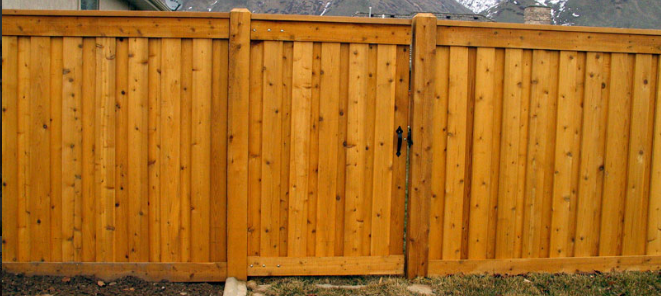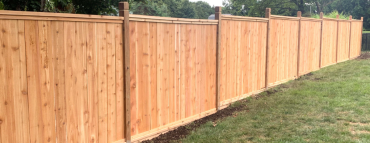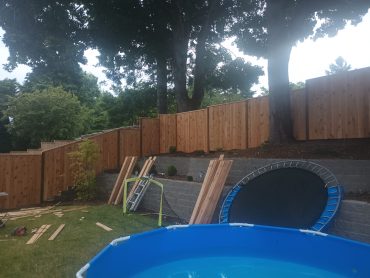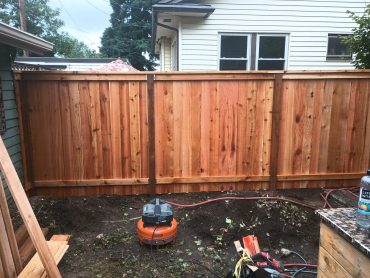Are you looking for a fence that will transform your backyard? Do you want to add some privacy and security to your residential area? Look no further than a board on board fence.
These styles of fences are a type of fencing that provide an excellent barrier for privacy. They consist of vertical boards with a small gap between them, allowing air and light to pass through while still maintaining privacy. The top cap provides additional protection against weather elements.
These fences have been around for centuries, dating back to the ancient Egyptians who used them as barriers for their gardens. Today, they are popular in residential areas where homeowners value their privacy and security.
The importance of having a reliable fence cannot be overstated. With the rise in crime rates, it is crucial to have a barrier that can deter unwanted visitors from entering your property. A board on board fence provides just that – a sturdy and secure boundary that keeps intruders out while allowing you to enjoy your outdoor space without any prying eyes.
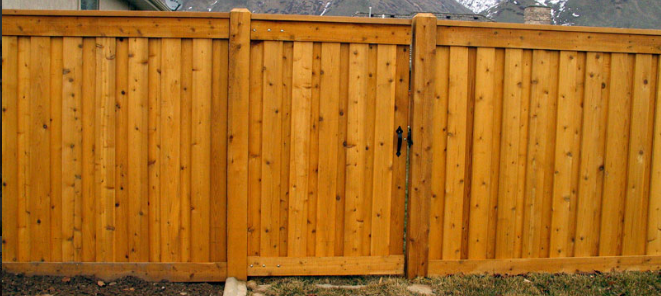
Benefits of a Board on Board Privacy Fence
Increased Privacy and Security for Homeowners
Board on board fences are an excellent choice for homeowners who want to increase their privacy and security. The fence design consists of overlapping boards that create a solid barrier between your yard and the outside world. This type of fence is perfect for those who have nosy neighbors or live near busy streets.
With a board on board fence, you can enjoy your backyard without worrying about prying eyes or unwanted visitors. You can also rest easy knowing that your children and pets are safe from harm.
Enhanced Aesthetic Appeal and Property Value
A board on board fence not only provides privacy and security but also enhances the aesthetic appeal of your property. The overlapping boards give the fence a unique look that adds character to any home.
Moreover, installing a beautiful fence can significantly increase your property value. Potential buyers will appreciate the added privacy, security, and beauty that this type of fence provides.
Protection from Harsh Weather Conditions
Another benefit of having a nice fence is protection from harsh weather conditions. The overlapping boards provide extra insulation against wind, rain, snow, and other elements that could damage your property.
In areas where strong winds are common, a board on board fence can help prevent damage to outdoor furniture, plants, and other items in your yard.
Inspiration and Ideas for Board on Board Fences
Different Styles and Designs for Board on Board Fences
Overlapping fence boards is a classic style of fence that offers privacy, security, and beauty to your property. This type of fence consists of horizontal boards or panels that overlap each other to create a solid surface with no gaps in between. There are different styles and designs of board on board fences that you can choose from depending on the look and feel you want to achieve.
One popular style is the horizontal board fence, which features boards that run parallel to the ground. This design creates a modern and sleek appearance that complements contemporary homes. Another option is the shadowbox fence, which has alternating boards on either side of the rails, creating a patterned effect that allows light to pass through while still providing privacy.
If you prefer a more traditional look, consider the picket-style board on board fence. This design has vertical pickets attached to horizontal rails with small gaps in between them. It offers a classic charm while still providing adequate privacy.
Creative Ways to Incorporate Landscaping with the Fence
These fences can be used as an excellent backdrop for landscaping features such as gardens, flower beds, or even water fountains. You can also use climbing plants like ivy or roses to add color and texture to your fence’s surface.
Another creative way to incorporate landscaping with your fence is by adding planter boxes along its sides. These boxes can be made from cedar wood similar to your fence material or any other suitable material you prefer. They offer an elegant way of showcasing flowers or herbs while creating an attractive boundary around your property.
Examples of How Other Homeowners Have Used this Type of Fencing
Board on board fencing provides homeowners with many options. Here are some examples of how other homeowners have used this type of fencing:
-
A board on board fence with a lattice top was used to create an elegant outdoor seating area that provides privacy and shade.
-
A horizontal overlapping board fence can be installed around the perimeter of a modern homes to create a sleek and contemporary look.
-
A shadowbox fence can be used to create a private backyard oasis while still allowing light to pass through.
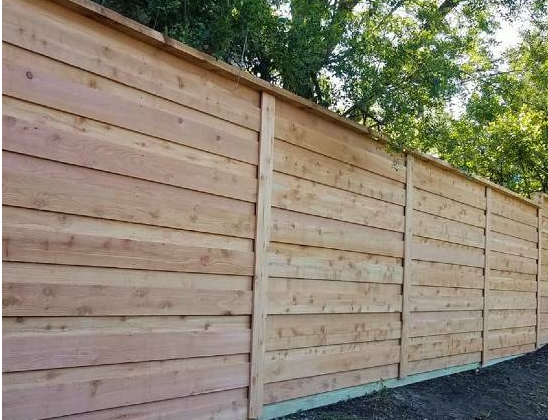
Materials for Building a Board on Board Fence
Types of Wood Commonly Used for Building a Board on Board Fence
One of the most popular materials used in building these styles of fences is wood. The type of wood you choose will determine the durability, look, and cost-effectiveness of your fence. Cedar fencing is one of the most popular types of wood used in building board on board fences because it’s naturally resistant to rot and insects. Another popular choice is pressure-treated lumber since it’s affordable and durable.
However, other types of wood can also be used, such as redwood or cypress. Redwood has a natural resistance to decay and insects, making it an excellent choice for areas with high moisture content. Cypress is another option that’s naturally resistant to decay and insects but can be more expensive than cedar or pressure-treated lumber.
When choosing the type of wood for your fence, consider your budget, location, climate, and desired look. Some woods may require more maintenance than others to keep their appearance over time.
Other Materials That Can Be Used
While wood is the most common material used in building fences, there are other options available as well. Vinyl fencing has become increasingly popular due to its low maintenance requirements and durability. It can mimic the look of traditional wooden fences without requiring staining or painting.
Composite fencing is another alternative made from a combination of plastic and recycled wood fibers. It offers similar benefits as vinyl fencing with added strength and durability.
Metal fencing can also be used in place of wood for a modern look that requires little maintenance. However, metal fences may not provide the same level of privacy as wooden ones.
When considering alternative materials for your board on board fence, weigh the pros and cons against traditional wooden options based on factors such as cost, maintenance requirements, durability, aesthetics, and privacy needs.
Factors to Consider When Choosing Materials
There are several factors to consider when choosing materials for your fence. The first consideration should be the purpose of the fence. Is it for privacy, security, or aesthetics? This will help determine the height and material needed.
The second factor is location and climate. If you live in an area with high moisture content or harsh weather conditions, you’ll need a material that can withstand these elements. Cedar fencing may not be suitable for areas with high humidity levels since it’s prone to warping and rotting over time.
The third factor to consider is maintenance requirements. Some materials require more upkeep than others, such as wood fences that need regular staining or painting to maintain their appearance. Vinyl and composite fencing require less maintenance but may not have the same natural look as wood.
Lastly, consider your budget when choosing materials for your board on board fence. Wood fencing can be affordable depending on the type of wood used, while vinyl and composite fencing tend to be more expensive upfront but require less maintenance over time.
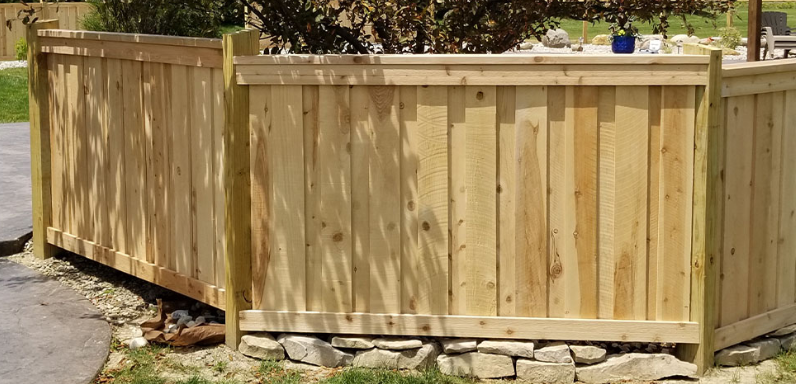
Design Considerations for a Board on Board Fence
Height and Width Considerations
When designing a board on board fence, one of the most important considerations is the height and width of the fence. The height will depend on your specific needs, such as privacy or security. It’s essential to check with your local building codes to ensure that you follow any regulations regarding fence height.
The width of the boards used in your fence can also affect its overall appearance and functionality. Wider boards provide more privacy, while narrower boards allow for better airflow. If you live in an area with high winds or severe weather conditions, wider boards may be more durable.
Choosing Between Vertical or Horizontal Boards
Another critical design consideration when building a fence is whether to use vertical or horizontal boards. Vertical boards tend to be more traditional and offer a classic look that complements many architectural styles. They also provide better privacy as there are no gaps between the boards.
Horizontal boards, on the other hand, create a modern and contemporary look that works well with minimalist designs. They also allow for airflow through the gaps between each board and can help reduce wind resistance during storms.
When deciding between vertical or horizontal boards, consider your personal style preferences and how they will complement your home’s architecture.
Decorative Elements
Adding decorative elements to your fence can enhance its overall aesthetic appeal while providing additional benefits such as increased durability or security.
Post caps are an excellent addition that adds both style and function by protecting exposed post tops from weather damage while adding an elegant finish to your fence design.
Lattice work is another popular decorative element that adds visual interest while increasing privacy by partially blocking views into your yard. It’s available in various patterns from simple squares to intricate designs like diamond shapes or curves.
Other options include using different stains or paint colors for added personality, incorporating lighting fixtures along the top railings for nighttime ambiance, or adding climbing plants and vines to create a living fence.
Installation Process for a Board on Board Fence
Steps involved in installing a board-on-board fence
Installing a board-on-board fence requires careful planning and execution. Here are the steps to follow:
-
Measure the perimeter of your property: The first step is to measure the perimeter of your property to determine how much fencing material you will need.
-
Purchase materials: Once you have measured the perimeter, purchase all required materials such as wood panels, trim rails, posts, concrete mix, screws or nails, and gate hardware.
-
Mark out post locations: Use stakes and string lines to mark out where each post should be placed along the fence line.
-
Dig holes for posts: Using a post-hole digger or auger, dig holes for each post at least 2 feet deep.
-
Set posts in concrete: Place each post in its hole and fill with concrete mix until level with the ground surface.
-
Install rails: Attach horizontal trim rails to each side of the posts using screws or nails.
-
Attach fence panels: Starting at one end of the fence line, attach each panel by screwing or nailing it into place on the trim rails.
-
Cap off fence: Add top caps to each post for added stability and aesthetic appeal.
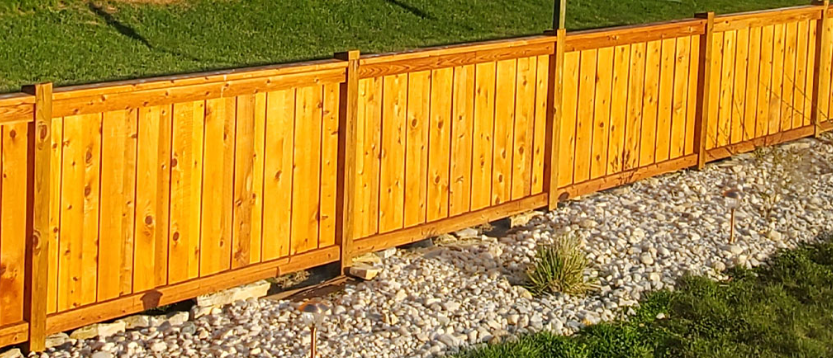
Tools required during installation process
To install a board-on-board fence properly, you will need several tools:
-
Post-hole digger or auger
-
Level
-
Measuring tape
-
String line
-
Circular saw or handsaw
-
Screwdriver or drill with screw bit/nail gun
Having these tools readily available will make your installation process smoother and more efficient.
Tips to ensure proper installation
Here are some tips that can help ensure proper installation of your board-on-board fence:
-
Choose quality materials: Invest in high-quality wood panels and other materials that are designed specifically for outdoor use as they are more durable and long-lasting.
-
Plan for slope: If your property slopes, plan accordingly by installing the fence in a stepped or racked fashion to ensure proper alignment.
-
Check local building codes: Before starting any fence installation project, it is essential to check your local building codes and zoning regulations to ensure compliance.
-
Allow for expansion and contraction: Wood panels will expand and contract with temperature changes, so leave some space between each panel to accommodate this movement.
-
Use screws instead of nails: Screws provide better holding power than nails and are less likely to pull out over time.
-
Maintain your fence: Regular maintenance such as staining or painting can help prolong the life of your board-on-board fence and keep it looking great for years to come.
Why a Board on Board Fence is the Best Choice for Your Home
Advantages over Other Types of Fencing
If you’re looking to fence your property, there are many options available in the market. However, an overlapping board fence stands out as one of the best choices for your home due to its numerous advantages over other types of fencing.
Firstly, compared to chain link or picket fences, board on board fences offer more privacy and security. The overlapping design creates a solid barrier that prevents outsiders from peering into your yard and deters trespassers from entering your property. This feature is especially important if you have children or pets who need to play safely in your yard without worrying about strangers.
Secondly, these fences are more aesthetically pleasing than other types of fencing. They provide a clean and classic look that complements any architectural style. They add value to your property by enhancing its curb appeal.
Thirdly, the overlapping fence require less maintenance than other types of fencing. Unlike wooden picket fences that may rot or warp over time, this type of fence can withstand harsh weather conditions and last for decades with minimal upkeep.
Durability and Longevity
One of the most significant advantages of a board on board fence is its durability and longevity. These fences are built using high-quality materials such as cedar or redwood that can resist rotting, warping, and insect damage.
Moreover, the overlapping design provides extra support against strong winds and heavy rainstorms that could otherwise cause damage to other types of fencing. This feature ensures that your fence remains standing even during extreme weather conditions.
Another factor contributing to the longevity of a board on board fence is its construction method. Unlike other types of fencing where each panel is attached separately using nails or screws, these panels interlock with each other using tongue-and-groove joints. This design distributes weight evenly along the fence, making it sturdier and less likely to sag or lean over time.
Customization Options
Another advantage of a board on board fence is the customization options available. You can choose from various materials, colors, and styles to create a fence that reflects your personal taste and complements your property’s architecture.
For instance, you can opt for a stained finish that matches the color of your house or go for a natural wood finish that adds warmth and texture to your yard. You can choose between different heights and widths depending on your privacy needs.
Moreover, board on board fences offer flexibility in terms of design. You can add decorative elements such as lattice panels or post caps to give your fence a unique look. Furthermore, you can incorporate gates into the design to provide easy access to your yard while still maintaining security and privacy.
Board on Board Fence vs Shadow Box Fence: Which One is Right for You?
Differences between shadow box and board-on-board fences
You may be considering a board-on-board fence or a shadow box fence. Both options have their unique features and benefits, but understanding the differences between them can help you make an informed decision.
A board-on-board fence is constructed by overlapping vertical boards on top of each other, creating a solid panel with no gaps between the boards. This design offers maximum privacy and security since there are no visible gaps in the fence. On the other hand, a shadow box fence is built by placing boards on both sides of the horizontal rails, leaving small gaps between each board. This design creates an attractive pattern while still providing some level of privacy.
Pros and cons of each type
Before deciding which type of fence to install, it’s essential to consider the pros and cons of each option.
Board-on-Board Fence Pros
-
Maximum privacy: The solid panel design provides complete privacy from neighbors or passersby.
-
Increased security: Since there are no visible gaps in the fence, it’s challenging for intruders to climb over.
-
Durability: The overlapping boards provide additional strength and stability to withstand harsh weather conditions.
Board-on-Board Fence Cons
-
Costly: Due to its construction method and materials required, this type of fence can be more expensive than other options.
-
Maintenance: While durable, a board-on-board fence requires regular maintenance such as painting or staining to prevent rotting or warping.
Shadow Box Fence Pros
-
Aesthetic appeal: The unique design provides an attractive pattern that adds visual interest to any property.
-
Good airflow: The small gaps between each board allow air circulation through the fence.
-
Affordability: Compared to a board-on-board fence, this option can be more cost-effective.
Shadow Box Fence Cons
-
Less privacy: While still providing some level of privacy, a shadow box fence does not offer complete coverage.
-
Security concerns: The gaps between each board make it easier for intruders to climb over the fence.
-
Maintenance: Similar to a board-on-board fence, regular maintenance is required to prevent rotting or warping.
Factors to consider when deciding which one to choose
When choosing between a board-on-board fence and a shadow box fence, several factors should be considered.
Property location
The location of your property can play an important role in determining which type of fence is suitable. If you live in an area with high foot traffic or close proximity to neighbors, these types of fences may provide the necessary privacy and security. However, if you live in an open area without many neighbors, a shadow box fence can provide an attractive design while still offering some level of privacy.
Budget
Your budget is another critical factor when deciding on which type of fence to install. A board-on-board fence can be more expensive due to its construction method and materials required. In contrast, a shadow box fence can be more affordable while still providing an attractive design.
Personal preference
Ultimately, your personal preference will play the most significant role in determining which type of fence to install. Consider what features are most important to you – do you prioritize maximum privacy and security or aesthetic appeal? Understanding your preferences will help you make the best decision for your property.
How Long Will a Board-on-board Fence Last? Discover Its Longer Lifespan.
Durability Factors That Affect Lifespan
A board-on-board fence is a popular choice for homeowners who want privacy and security. However, the durability of this type of fence depends on several factors. One of the most important factors is the quality of the materials used to build it. If you use high-quality wood, your fence will last longer than if you use lower-quality wood.
Another factor that affects the lifespan of a board-on-board fence is how well it’s built. If your fence is constructed properly, with strong joints and sturdy posts, it will be able to withstand harsh weather conditions and other external factors that can cause damage over time.
Lastly, environmental factors play a significant role in determining how long your board-on-board fence will last. For example, if you live in an area with high humidity or frequent rainfall, your fence may be more prone to rotting or warping.
Maintenance Tips to Extend Its Life Span
To ensure that your fence lasts as long as possible, regular maintenance is crucial. Here are some tips to help extend its life span:
-
Clean Your Fence Regularly: Dirt and debris can accumulate on your fence over time, which can lead to mold growth and other issues. Use a pressure washer or hose to clean off any buildup regularly.
-
Stain or Paint Your Fence: Staining or painting your board-on-board fence can help protect it from UV rays and moisture damage. Be sure to choose a product specifically designed for outdoor use.
-
Trim Nearby Trees and Shrubs: Overhanging branches and shrubs can scratch up against your fence, causing scratches and other damage over time.
-
Repair Damage Promptly: If you notice any signs of damage such as loose boards or broken posts, repair them promptly before they worsen.
Factors That May Shorten Its Lifespan
Despite your best efforts, there are still some factors that can shorten the lifespan of your fence. Here are a few things to watch out for:
-
Insects and Pests: Termites and other wood-boring insects can cause significant damage to your fence over time, leading to rotting and warping.
-
Harsh Weather Conditions: Extreme temperatures, high winds, and heavy rain or snowfall can all take a toll on your fence.
-
Poor Installation: If your fence wasn’t installed correctly in the first place, it may be more prone to damage over time.
-
Lack of Maintenance: Neglecting regular maintenance tasks like cleaning and staining can significantly shorten the lifespan of your board-on-board fence.
Pros and Cons of Board-on-board Fences: Insights from a Good Neighbor Fence Contractor
Advantages of Board-on-board Fences
Board-on-board fences are an excellent choice for homeowners who want to increase privacy, security, and curb appeal. Here are some advantages of board-on-board fences:
-
Enhanced Privacy: This style of fencing provides complete privacy as the boards overlap each other, leaving no gaps between them. This feature makes it perfect for homeowners who want to enjoy their outdoor space without worrying about prying eyes.
-
Increased Security: A lapped board fence is more secure than other types of fences because it has no gaps or holes that intruders can use to gain access to your property. Furthermore, the overlapping design adds strength and durability to the fence.
-
Improved Curb Appeal: These fences have a classic look that enhances the beauty of any property. They come in various styles and designs, making them versatile enough to complement any home’s architectural style.
Disadvantages of Board-on-board Fences
While there are many benefits to installing a board-on-board fence, there are also some disadvantages that you should consider before making your decision:
-
Cost: Board-on-board fences tend to be more expensive than other types of fencing due to their design and materials used. However, they offer superior quality and longevity compared to cheaper alternatives.
-
Maintenance: Due to their design, cleaning and maintaining a board-to-board fence can be challenging. Dirt and debris can accumulate between the boards over time, leading to rotting or warping if not cleaned regularly.
-
Installation Time: Installing a board-to-board fence takes longer than other types of fencing because each board must be precisely placed on top of another.
Factors To Consider When Deciding If A Board-On-Board Fence Is Right For You
Before deciding whether this type of fence is suitable for your needs, here are some factors you should consider:
-
Purpose: Determine why you need a fence. If you want to increase privacy and security, then a board-to-board fence is an excellent choice. However, if your primary goal is to keep pets or children in the yard, then other types of fencing may be more suitable.
-
Budget: These fences are more expensive than other fencing options due to their design and materials used. Therefore, it’s essential to determine your budget before making a decision.
-
Maintenance: These fences require regular maintenance as dirt and debris can accumulate between the boards over time. Consider whether you’re willing to invest time and effort into cleaning and maintaining your fence regularly.
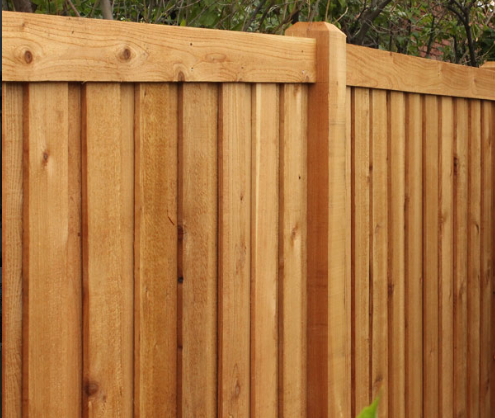
Privacy vs Semi-Privacy Fence: Why You Need a Board on Board Fence
A board on board fence is an excellent choice for homeowners who value their privacy and want to create a secure outdoor living space. This type of fence provides maximum coverage, making it difficult for anyone to see inside your property.
Benefits of a Board on Board Privacy Fence
One of the primary benefits of a board on board fence is that it provides complete privacy. The overlapping boards create a solid barrier that blocks out any unwanted views from neighbors or passersby. This type of fence offers better wind resistance than other styles due to its construction.
Another advantage is that you can customize the height and width according to your needs. Whether you want to keep pets in or prevent intruders from entering your property, a this fence can be tailored to meet your specific requirements.
Inspiration and Ideas for Board on Board Fences
When choosing a design for your board-on-board fence, there are many options available. Some popular choices include adding decorative elements such as lattice work or scalloped edges. You can also choose between different materials such as wood or vinyl, depending on your personal preference and budget.
Materials for Building a Board on Board Fence
Wood is the most common material used in building board-on-board fences due to its affordability and durability. Cedar and redwood are popular choices because they are naturally resistant to decay and insects. However, vinyl fencing has become increasingly popular in recent years due to its low maintenance requirements.
Design Considerations for a Board on Board Fence
When designing your fence, consider factors such as wind resistance, height restrictions, and local zoning laws. It’s essential to choose materials that will withstand harsh weather conditions while adhering to local regulations.
Installation Process for a Board on Board Fence
The installation process for a board-on-board fence can be challenging, especially if you are not experienced in building fences. It’s essential to consult with a professional fencing contractor who has the necessary skills and equipment to ensure that your fence is installed correctly.
Board on Board Fence vs Shadow Box Fence: Which One is Right for You?
A shadow box fence is another popular option that offers semi-privacy while still allowing some light and air to pass through. However, if privacy is your primary concern, then a board-on-board fence is the better choice.
How Long Will a Board-on-board Fence Last? Discover Its Longer Lifespan.
With proper maintenance and care, a board-on-board fence can last up to 20 years or more. Regular cleaning and staining will help prolong its lifespan and maintain its appearance.
Pros and Cons of Board-on-board Fences: Insights from a DFW Fence Contractor
Pros:
-
Provides maximum privacy
-
Customizable height and width
-
Better wind resistance than other styles
-
Can be made from various materials
Cons:
-
More expensive than other types of fences
-
Requires regular maintenance to prevent rotting or warping
FAQs
What makes a board on board fence different from other types of fences?
A board on board fence provides complete privacy due to the overlapping boards that create a solid barrier. This type of fence also offers better wind resistance than other styles due to its construction.
What materials are used in building a board on board fence?
Wood is the most common material used in building board-on-board fences due to its affordability and durability. Cedar and redwood are popular choices because they are naturally resistant to decay and insects. Vinyl fencing has become increasingly popular in recent years due to its low maintenance requirements.
How long will my board on board fence last?
With proper maintenance and care, a board-on-board fence can last up to 20 years or more. Regular cleaning and staining will help prolong its lifespan and maintain its appearance.
Can I customize the height and width of my board on board fence?
Yes, you can customize the height and width of your board-on-board fence according to your needs. Whether you want to keep pets in or prevent intruders from entering your property, a board-on-board fence can be tailored to meet your specific requirements.
How do I install a board on board fence?
The installation process for a board-on-board fence can be challenging, especially if you are not experienced in building fences. It’s essential to consult with a professional fencing contractor who has the necessary skills and equipment to ensure that your fence is installed correctly.
What is the difference between a board on board fence and a shadow box fence?
A shadow box fence offers semi-privacy while still allowing some light and air to pass through. However, if privacy is your primary concern, then a board-on-board fence is the better choice.

